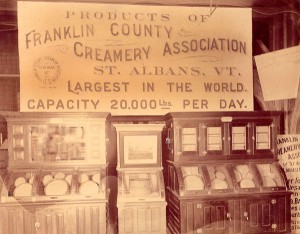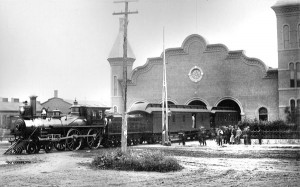ST. ALBANS — St. Albans in 1864 was a booming community. A railroad line completed in the 1840s had opened a previously isolated town to interstate and international trade, while the need for rail lines and cars spurred manufacturing.

The Franklin County Creamery’s (precursor to the St. Albans Cooperative Creamery) display at the Food & Health Exposition in 1891.
St. Albans was served by two railroads – the Central Vermont and the Vermont and Canada. Through the machinations of the Smith and Brainerd families, the Central Vermont railroad was given to the Vermont and Canada in 1855 by court order. In 1862, the Central Vermont shifted its headquarters to St. Albans, already home to the Vermont and Canada.
Following the relocation, a number of new railroad buildings were constructed, including a roundhouse, machine shop, passenger depot and a 350-foot train shed.
With the advent of rail cars kept cold by ice in the 1850s, St. Albans quickly became one of the leading providers of butter to Boston. The butter trains left St. Albans on Tuesday and the St. Albans raiders likely noticed the amount of money in the town on Wednesday, the day they chose to rob three local banks.
R. R. Sherman, author of the 1872 work, “The Origin of the St. Albans Butter Market,” described the scene as follows: “St. Alban presents a lively appearance on Tuesday during the Spring, Summer and Fall… Teams are hitched on every post on Main Street, the hotel barn and yards are full, the hotels are full and the farmers, I mean their pockets, are full. Butter is king.”
In 1851, 60 tons of butter and 275 tons of cheese were shipped to Boston by the Vermont Central. By 1865, that number had increased to 1,514 tons of butter and 587 tons of cheese. Cheese shipments would peak in 1869, but Vermont would continue to have an international reputation for quality butter into the 20th Century. In the 1890s, the Franklin County Creamery Association – precursor of the St. Albans Cooperative Creamery — was operating the largest butter factory in the world, making 25,000 pounds a day.
Maple sugar products began to grow in popularity in the decades before the Civil War, as cane sugar was increasingly associated with slavery. The war itself drastically reduced access to cane sugar. Vermont’s production of maple sugar increased along with demand, reaching 9 million pounds in 1870. Vermont would ultimately make a full fourth of the nation’s maple sugar before a reduction in cane sugar tariffs in the 1880s decimated the maple sugar industry.

The photo shows the former train shed, which was once attached to the station, but unfortunately was demolished.
Expanding railroads needed cars and track. Smith, Brainerd & Company, owned by the sons of St. Albans founders John Smith and Lawrence Brainerd, made rail cars for the Vermont Central and the Vermont and Canada before being purchased by the latter for $210,000 in 1855.
Iron for the cars was coming from the St. Albans Foundry, located on the corner of Federal and Lake Streets. Controlled by Worthington Smith, brother of Gov. J. Gregory Smith, the foundry also made farm equipment and household goods, including teakettles.
Between them the two railroads employed more than 1,000 people in the 1860s, with salaries ranging from $467 per month for the six freight clerks to $1 per day for the 276 men in the repair shops, the 20 switchmen, and other laborers. The majority was being paid $1 to $2 per day.
Downtown St. Albans benefitted from the railroads and the increased trade they brought, with a variety of shops on Main Street including clothing, drug and general stores, as well as hotels and livery stables.
By MICHELLE MONROE
St. Albans Messenger Staff Writer



